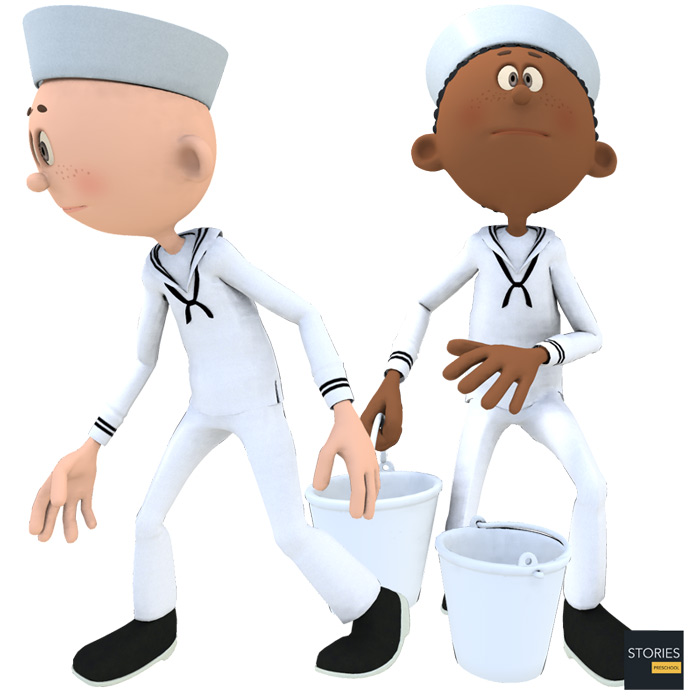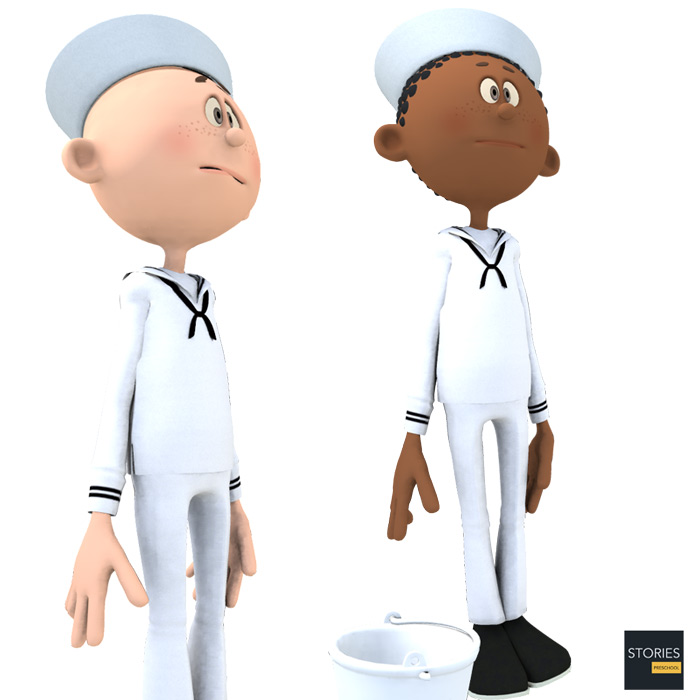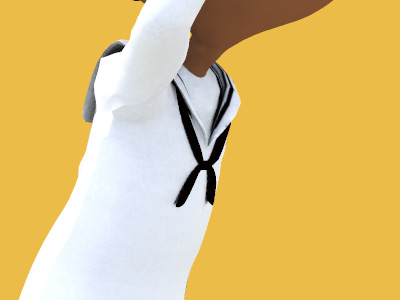Sailor
A sailor, seaman, mariner, or seafarer is a person who navigates waterborne vessels or assists as a crewmember in their operation and maintenance. The term bluejacket may be used for British or US Navy enlisted sailors, the latter especially when deployed ashore as infantry. The Bluejacket's Manual is the basic handbook for United States Navy personnel. 700,000 of the world's mariners come from the Philippines, being the world's largest origin of seafarers.
Etymologically, the name "sailor" preserves the memory of the time when ships were commonly powered by sails, but it applies to the personnel of all vessels, whatever their mode of propulsion, and includes military (naval) and security (coast guard) maritime personnel and members of the merchant marine, as well as recreational sailors. The term "seaman" is frequently used in the particular sense of a sailor who is not an officer.

Professional mariners
Seafarers hold a variety of professions and ranks, each of which carries unique responsibilities which are integral to the successful operation of an ocean-going vessel. A ship's crew can generally be divided into four main categories: the deck department, the engineering department, the steward's department, and others.
Deck department
Officer positions in the deck department include but are not limited to: master and his chief, second and third officers. The official classifications for unlicensed members of the deck department are able seaman and ordinary seaman. With some variation, the chief mate is most often charged with the duties of cargo mate. Second Mates are charged with being the medical officer in case of medical emergency. All three mates each do four-hour morning and afternoon shifts on the bridge, when underway at sea.
A common deck crew for a ship includes:
- (1) Chief Officer/ Chief Mate
- (1) Second Officer / Second Mate
- (1) Third Officer / Third Mate
- (1) Cadet / Officer Cadet
- (1) Boatswain
- (2-8) Able seamen
- (0-3) Ordinary seamen
Engineering department
A ship's engineering department consists of the members of a ship's crew that operates and maintains the propulsion and other systems on board the vessel. Marine engineering staff also deal with the "hotel" facilities on board, notably the sewage, lighting, air conditioning and water systems. Engineering staff manage bulk fuel transfers, from a fuel-supply barge in port. When underway at sea, the second and third engineers will often be occupied with oil transfers from storage tanks, to active working tanks. Cleaning of oil purifiers is another regular task. Engineering staff are required to have training in firefighting and first aid. Additional duties include maintaining the ship's boats and performing other nautical tasks. Engineers play a key role in cargo loading/discharging gear and safety systems, though the specific cargo discharge function remains the responsibility of deck officers and deck workers.
A common engineering crew for a ship includes:
- (1) Chief Engineer
- (1) Second Engineer / First Assistant Engineer
- (1) Third Engineer / Second Assistant Engineer
- (1-2) Fourth Engineer / Third Assistant Engineer
- (0-2) Fifth Engineer / Junior Engineer
- (1-3) QMED (unlicensed qualified rating: Qualified member Engine Dept.)
- (1-3) Oiler (unlicensed qualified rating)
- (0-3) Greaser/s (unlicensed qualified rating)
- (1-5) Entry-level rating (such as Wiper (occupation), Utilityman, etc.)
USA ships also carry a qualified member of the engine department. Other possible positions include motorman, machinist, electrician, refrigeration engineer and tankerman.
Steward's department
A typical steward's department for a cargo ship is a chief steward, a chief cook and a steward's assistant. All three positions are typically filled by unlicensed personnel.
The chief steward directs, instructs, and assigns personnel performing such functions as preparing and serving meals; cleaning and maintaining officers' quarters and steward department areas; and receiving, issuing, and inventorying stores.
The chief steward also plans menus; compiles supply, overtime, and cost control records. The steward may requisition or purchase stores and equipment. Galley roles may include baking.
A chief steward's duties may overlap with those of the steward's assistant, the chief cook, and other Steward's department crewmembers.
A person has to have a Merchant Mariner's Document issued by the United States Coast Guard in the United States Merchant Marine in order to serve as a chief steward. All chief cooks who sail internationally are similarly documented by their respective countries because of international conventions and agreements.
The only time that steward department staff are charged with duties outside the steward department, is during the execution of the fire and boat drill.

Other departments
Various types of staff officer positions may exist on board a ship, including junior assistant purser, senior assistant purser, purser, chief purser, medical doctor, professional nurse, marine physician assistant and hospital corpsman. These jobs are considered administrative positions and are therefore regulated by Certificates of Registry issued by the United States Coast Guard. Pilots are also merchant marine officers and are licensed by the Coast Guard.
Working conditions
Mariners spend extended periods at sea. Most deep-sea mariners are hired for one or more voyages that last for several months. There is no job security after that. The length of time between voyages varies by job availability and personal preference.
The rate of unionization for these workers in the United States is about 36 percent, much higher than the average for all occupations. Consequently, merchant marine officers and seamen, both veterans and beginners, are hired for voyages through union hiring halls or directly by shipping companies. Hiring halls fill jobs by the length of time the person has been registered at the hall and by their union seniority. Hiring halls typically are found in major seaports.
At sea, on larger vessels members of the deck department usually stand watch for 4 hours and are off for 8 hours, 7 days a week.
Mariners work in all weather conditions. Working in damp and cold conditions often is inevitable, although ships try to avoid severe storms while at sea. It is uncommon for modern vessels to suffer disasters such as fire, explosion, or a sinking. Yet workers face the possibility of having to abandon ship on short notice if it collides with other vessels or runs aground. Mariners also risk injury or death from falling overboard and from hazards associated with working with machinery, heavy loads, and dangerous cargo. However, modern safety management procedures, advanced emergency communications, and effective international rescue systems place modern mariners in a much safer position.
Most newer vessels are air conditioned, soundproofed from noisy machinery, and equipped with comfortable living quarters. These amenities have helped ease the sometimes difficult circumstances of long periods away from home. Also, modern communications, especially email, link modern mariners to their families. Nevertheless, some mariners dislike the long periods away from home and the confinement aboard ship. They consequently leave the profession.
Life at sea
Professional mariners live on the margins of society, with much of their life spent beyond the reach of land. They face cramped, stark, noisy, and dangerous conditions at sea. Yet men and women still go to sea. For some, the attraction is a life unencumbered with the restraints of life ashore. Seagoing adventure and a chance to see the world also appeal to many seafarers. Whatever the calling, those who live and work at sea invariably confront social isolation.
Findings by the Seafarer's International Research Center indicate a leading cause of mariners leaving the industry is "almost invariably because they want to be with their families". U.S. merchant ships typically do not allow family members to accompany seafarers on voyages. Industry experts increasingly recognize isolation, stress, and fatigue as occupational hazards. Advocacy groups such as International Labor Organization, a United Nations agency, and the Nautical Institute seek improved international standards for mariners.
One’s service aboard ships typically extends for months at a time, followed by protracted shore leave. However, some seamen secure jobs on ships they like and stay aboard for years. In rare cases, veteran mariners choose never to go ashore when in port.
Further, the quick turnaround of many modern ships, spending only a matter of hours in port, limits a seafarer's free-time ashore. Moreover, some seafarers entering U.S. ports from a watch list of 25 countries deemed high-risk face restrictions on shore leave due to security concerns in a post 9/11 environment. However, shore leave restrictions while in U.S. ports impact American seamen as well. For example, the International Organization of Masters, Mates and Pilots notes a trend of U.S. shipping terminal operators restricting seamen from traveling from the ship to the terminal gate. Further, in cases where transit is allowed, special "security fees" are at times assessed.
Such restrictions on shore leave coupled with reduced time in port by many ships translate into longer periods at sea. Mariners report that extended periods at sea living and working with shipmates who for the most part are strangers takes getting used to. At the same time, there is an opportunity to meet people from a wide range of ethnic and cultural backgrounds. Recreational opportunities have improved aboard some U.S. ships, which may feature gyms and day rooms for watching movies, swapping sea stories, and other activities. And in some cases, especially tankers, it is made possible for a mariner to be accompanied by members of his family. However, a mariner’s off duty time at sea is largely a solitary affair, pursuing hobbies, reading, writing letters, and sleeping.
Internet accessibility is fast coming to the sea with the advent of cheap satellite communication, mainly from Inmarsat.
Sailor Suit
A sailor suit is a uniform traditionally worn by enlisted seamen in the navy, and other government funded sea services. It later developed into a popular clothing style for children, especially as dress clothes. View Story »





RESOURCES
This article uses material from the Wikipedia article "Sailor", which is released under the Creative Commons Attribution-Share-Alike License 3.0.
© Stories Preschool. All Rights Reserved.






